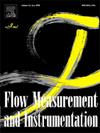基于声发射技术的非侵入式粒径测量方法研究
IF 2.3
3区 工程技术
Q2 ENGINEERING, MECHANICAL
引用次数: 0
摘要
为了克服波导对管道内流场的干扰和波导自身的磨损,提出了一种融合声发射传感器和数字间型静电传感器的非侵入式粒径测量方法。首先,在赫兹碰撞理论模型的基础上,通过理论分析,建立了粒子尺寸与粒子速度、声发射频率之间的数学模型;针对颗粒对管壁的垂直冲击速度难以获取的问题,提出了空间滤波和互相关相结合的垂直冲击速度获取方法。然后提出了RIME-VMD-FastICA算法对原始声发射信号进行去噪。最后搭建了气力输送系统,对0.4 mm、0.6 mm、0.8 mm、1.0 mm、1.2 mm 5种粒径的石英砂颗粒进行了实验。通过分析空间滤波速度、互相关速度和垂直冲击速度对粒径测量结果的影响,证明了非侵入式测量方法的可行性,发现使用垂直冲击速度时粒径误差最小,5种粒径的误差均小于10%。本文章由计算机程序翻译,如有差异,请以英文原文为准。
Research on non-intrusive particle size measurement method based on acoustic emission technology
In order to overcome the interference of the waveguide on the flow field in the pipe and its own wear, a novel non-intrusive particle size measurement method is proposed by fusing an acoustic emission sensor and an interdigital-type electrostatic sensor. Firstly, based on the theoretical model of Hertz collision, the mathematical model between particle size and particle velocity, as well as the acoustic emission frequency, is established through theoretical analysis. To address the challenge of obtaining the vertical impact velocity of particles against the pipe wall, a method combining spatial filtering and cross-correlation is introduced to acquire the vertical impact velocity. Then RIME-VMD-FastICA algorithm is proposed for denoising the raw acoustic emission signal. Finally, a pneumatic conveying system is set up, and experiments are conducted on quartz sand particles with five sizes of 0.4 mm, 0.6 mm, 0.8 mm, 1.0 mm, and 1.2 mm. By analyzing the influence of the spatial filtering velocity, the cross-correlation velocity, and the vertical impact velocity on the particle size measurement results, the feasibility of the non-invasive measurement method is proved, and it is found that the particle size error is the smallest when the vertical impact velocity is used, with the error of less than 10 % for all five particle sizes.
求助全文
通过发布文献求助,成功后即可免费获取论文全文。
去求助
来源期刊

Flow Measurement and Instrumentation
工程技术-工程:机械
CiteScore
4.30
自引率
13.60%
发文量
123
审稿时长
6 months
期刊介绍:
Flow Measurement and Instrumentation is dedicated to disseminating the latest research results on all aspects of flow measurement, in both closed conduits and open channels. The design of flow measurement systems involves a wide variety of multidisciplinary activities including modelling the flow sensor, the fluid flow and the sensor/fluid interactions through the use of computation techniques; the development of advanced transducer systems and their associated signal processing and the laboratory and field assessment of the overall system under ideal and disturbed conditions.
FMI is the essential forum for critical information exchange, and contributions are particularly encouraged in the following areas of interest:
Modelling: the application of mathematical and computational modelling to the interaction of fluid dynamics with flowmeters, including flowmeter behaviour, improved flowmeter design and installation problems. Application of CAD/CAE techniques to flowmeter modelling are eligible.
Design and development: the detailed design of the flowmeter head and/or signal processing aspects of novel flowmeters. Emphasis is given to papers identifying new sensor configurations, multisensor flow measurement systems, non-intrusive flow metering techniques and the application of microelectronic techniques in smart or intelligent systems.
Calibration techniques: including descriptions of new or existing calibration facilities and techniques, calibration data from different flowmeter types, and calibration intercomparison data from different laboratories.
Installation effect data: dealing with the effects of non-ideal flow conditions on flowmeters. Papers combining a theoretical understanding of flowmeter behaviour with experimental work are particularly welcome.
 求助内容:
求助内容: 应助结果提醒方式:
应助结果提醒方式:


